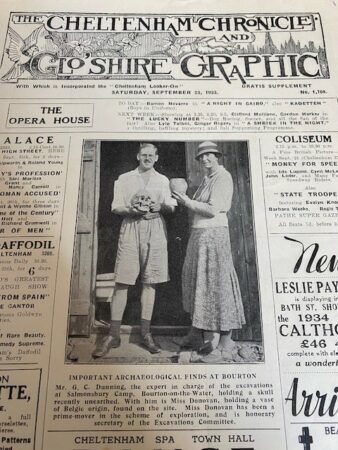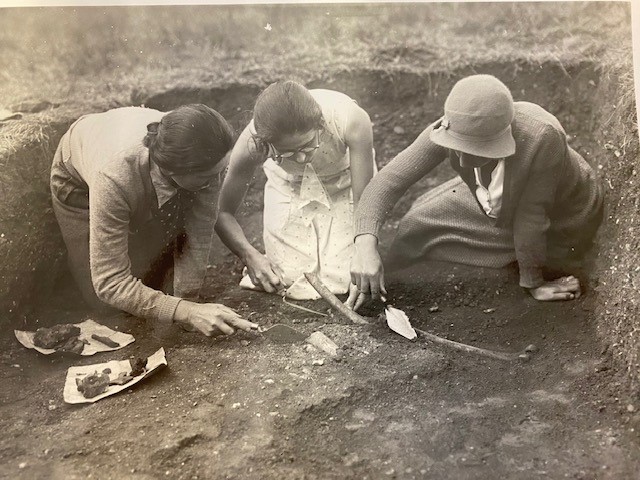Helen O’Neil was one of the pre-eminent archaeologists of the 20th century who contributed greatly to our understanding of the history of this part of the Cotswolds. In 1938, she was invited to become honorary curator here at the Corinium Museum in Cirencester. She was a force to be reckoned with, whose persistence and personality drove forward excavation work at Salmonsbury, as she pushed for funding, professional support and for the finds to be documented, published and displayed.

She was born Helen Donovan in 1893 and grew up in Bourton-on-the-Water at Camp House, which is on the west entrance of the Salmonsbury Iron Age camp. This location must have been an inspiration to her and in 1931, she became involved in excavation work at Salmonsbury.
In spring 2023, along with the incredible finds from the Salmonsbury digs over the years, the Corinium Museum was incredibly fortunate to receive the paper archive that accompanied it. This collection of reports, diagrams and plans, also includes a wealth of correspondence, some of which reveals much about Helen’s driving force, sharp wit and enduring friendship with the director of excavations at Salmonsbury, Gerald Dunning.
In an early communication with Dunning, who is not yet at the excavation site, she writes: “I am very sorry that you couldn’t get down to see what mischief we have been doing in the Camp.”
She describes organising an excavation committee meeting in his absence and promises: “We won’t pass any dreadful resolutions, but it will be an opportunity to get people together to remind them of the excavations and to get in cash.”
In the 1930s, men outnumbered women quite significantly in the field of archaeology and Helen was the only woman on the committee. But she encouraged other women to come to the site to take part in the excavation. She instructs Dunning that he “must” arrive in Salmonsbury by August 1st as a “crowd” from Bedford College was arriving to assist with excavations. Bedford was the first higher education institution for women, founded in 1840, and the archive contains photographs of groups of women working at Salmonsbury during the 1930s.
Helen was also in contact with another high-profile woman archaeologist of the time: Elsie Clifford. She writes to Dunning that Elsie is “an amazing woman”. But continues, in her usual sharp and witty style: “It will be amusing to see what she hopes to prove by that wondrously bilious map of hers. I never saw such a thing. I am sorry for Nympsfield (where Clifford was excavating a Long Barrow).”
Helen worked until well into her 80s, corresponding with the archaeological community about various digs and finds. She struggled with her health later on in life but, whenever she could, she was still determined and adventurous. In 1973, at the age of 80, Helen travelled to India to visit the place where her father had been a medical officer. Dunning replies to one of her letters “My, you had a grand time in India, riding about in state on an elephant! I would love to have seen you en route…”
One of Helen’s real skills was bringing life into often very dry, scientific and detailed archaeological reports. In one dig report of an excavation of a Long Barrow in Withington, Gloucestershire, she describes how the burnt floor of the antechamber was probably the work of a “marauding tribe, who in raiding the living inhabitants in the barrow forecourt, broke open the burial chamber scattering the bones before setting fire to the dwelling.” She says the tribe probably removed the skulls as trophies. She describes how the remaining skull fragments had a “hard, black, waxy feel and the appearance of ebony”. This, she says, gives us a clue to the roofing of the forecourt. Bones in this condition are the result of a very slow combustion, which could be due to a thatched roof, which would smoulder for days once it had fallen and lay on the floor.¹
As well as many digs in and around Bourton-on-the-Water during her lifetime, Helen worked on various archaeological sites at Roman villas, the city defences at Gloucester and Prestbury medieval moated manor site. She carried out work for the Ordnance Survey and the Ancient Monuments Inspectorate. Helen became a member of the Royal Archaeological Institute in 1932, she was elected Fellow of the Society of Antiquities in 1948 and honoured with an MBE for her contribution to archaeology in 1968. During her career, she also authored more than 40 academic articles on finds such as axes, coins and pottery. She died in 1984.
Some of the finds from the Salmonsbury digs will be going on display in the Corinium Museum very soon and a talk on Salmonsbury will take place in September. For more details and timings check our What’s On page or sign up to our social feeds on Instagram and Facebook.
¹Bristol and Gloucestershire Archaeological Society Volume 85, October 1962, pages 5-35










